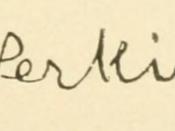Charlotte Gilman's The Yellow Wall-Paper gives readers insight of the oppressive standards Victorian era woman were expected to uphold to and the emergence of the then nascent feminist movement. Gilman's account of one woman's transformation is intriguingly symbolic and illustrates a universal theme very well known to women still: The struggle for recognition, to be viewed as capable against male counterparts and the need to be separate, but also equal. Although Gilman's clues are subtle, The Yellow Wall-Paper is a powerful feminist document, demanding the equality of women and illustrates a movement still in progress today.
At the beginning of the story, our narrator is nameless. She is wife to John, a respected physician. They have rented a colonial mansion for the summer where she may recuperate from a "nervous depression." The house, three miles from the village, is beautiful and grand with it hedges, gates, walkways and garden, but the narrator feels something strange about the house (perhaps its size and seclusion).
She dislikes the room her husband has chosen for a bedroom; a massive room on the top floor. The room is open and airy. During the day, it floods with sunshine through "windows that look all ways". Disturbingly, there are bars on the windows and "rings and things" in the walls. She concludes that the room has lived many past lives, at one time perhaps a gymnasium and lastly a nursery. The bed, resting in the center of the room, is either immovable or nailed to the floor. The narrator is troubled by the wallpaper; a sickly and "repellant" yellow, stripped off in gaping patches around the head of the bed and in another spot on the opposite side of the room. The narrator would have much rather preferred a room downstairs, one more nicely decorated,


